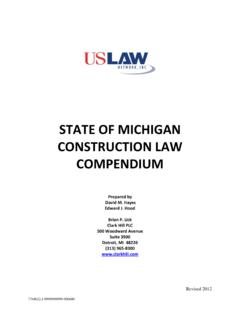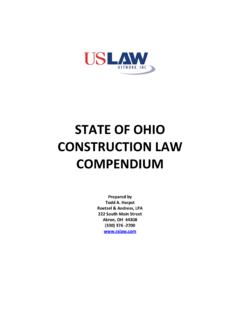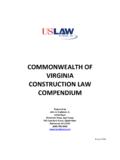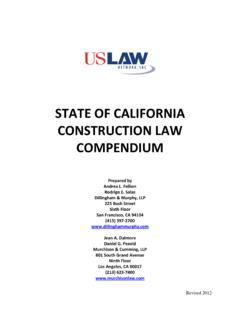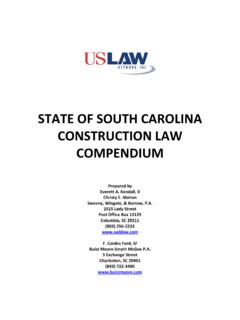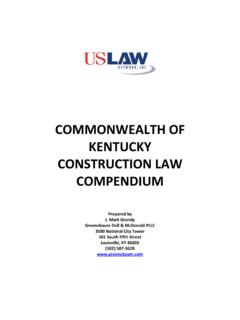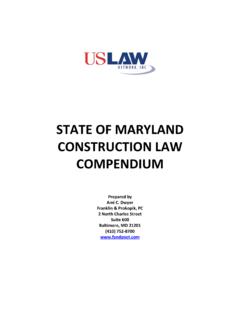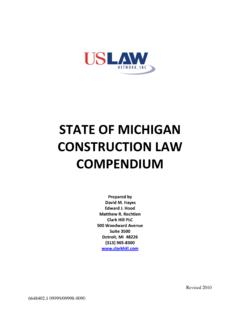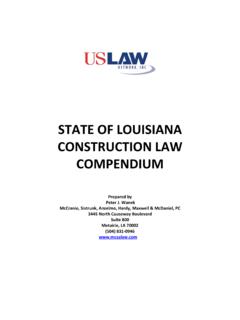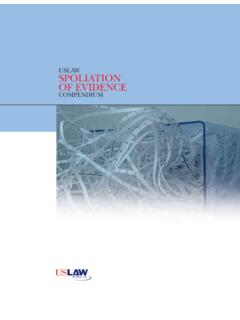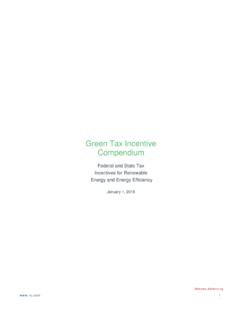Transcription of STATE OF ALABAMA CONSTRUCTION LAW COMPENDIUM
1 STATE OF ALABAMA CONSTRUCTION LAW COMPENDIUM Prepared by Kathy R. Davis Carr Allison 100 Vestavia Parkway Birmingham, AL 35216 (205) 949 2953 This outline includes a general overview of ALABAMA 's CONSTRUCTION law. The discussion on any particular topic is not necessarily an indication of the total law related to an area of CONSTRUCTION law. ALABAMA is a contributory negligence STATE and not a comparative negligence STATE . Contributory negligence in ALABAMA is negligence on the part of the plaintiff that proximately contributed to his injuries. ALABAMA is also a joint and several liability STATE which means a jury must return a single verdict that is based, in part, on the total culpability of all defendants.
2 ALABAMA does not recognize individual degrees of culpability among multiple defendants, and the jury has no discretion to assess damages against each individual defendant, because without recognition of each defendant's degree of culpability the jury would have no basis on which to apportion damages among the defendants. See Campbell v. Williams, 638 So. 2d 804 (Ala. 1994). Due to the harshness of the contributory negligence rule, ALABAMA juries sometimes disregard the court's instructions and engage in "jury nullification" on the issue of contributory negligence. See Royal and Richey v.
3 Safety Coatings, Inc., 655 So. 2d 927 (Ala. 1994). As in all courts, an ALABAMA jury verdict carries a presumption of correctness, and this presumption is strengthened when the trial court denies a motion for a new trial, especially when the trial court did not give incorrect, misleading, or erroneous jury instructions, and the trial court did not err in failing to give the requested jury instructions. I. Breach of Contract Typically, a breach of contract claim can be asserted by the purchaser against the general contractor, as well as by the general contractor against its subcontractors.
4 A breach of contract claim in ALABAMA is subject to a six year statute of limitations. See 6-2- 34 (1975). The statute of limitations does not begin to run when the contract is entered into, but rather when the cause of action accrues. See City of Birmingham v. Cochrane Roofing & Metal Co., Inc., 547 So. 2d 1159 (Ala. 1989); See also Stephens v. Creel, 429 So. 2d 278. (Ala. 1983). In a claim based on breach of warranty to construct a building in a workmanlike manner, the cause of action accrues, and the statute of limitations begins to run, on the date that the defendant completes performance.
5 Id. at 1163. The court in Cochrane opined that the breach of contract occurs when the builder fails to construct the house in an appropriate workmanlike manner. Id. ALABAMA law is clear that a breach-of- warranty cause of action against a contractor or architect accrues upon the completion of the building in regard to which the contractor or architect's work was done. Mitchell v. Richmond, 754 So. 2d 627, 629 (Ala. 1999). Under the new statute of repose, all civil actions in tort, contract, or otherwise for defects in design or CONSTRUCTION must be commenced within two years after the cause of action accrues, and any action that accrues more than 13 years after substantial completion of CONSTRUCTION is barred unless the injured party can show fraudulent concealment.
6 6-5-221 (1975). This is basically a restatement of the two year statute of limitations for a 2. negligence action and the six year statute of limitations on a breach of contract claim. See 6-2-34 (1975). This new statute has not been fully interpreted by the courts. II. Negligence Generally, an injury incurred due to negligent CONSTRUCTION may give rise to an action for breach of a contractor's common law duty of care, or negligence. An action for negligence in CONSTRUCTION could be based upon the contractor's poor workmanship, supervision, or design. The negligence claim against the general contractor may be limited by the economic loss rule.
7 This rule, in ALABAMA , bars a plaintiff from recovering under tort law when the product caused property damage only to itself. Carrell v. Masonite Corp., 775 So. 2d 121 (Ala. 2000); see also Lloyd Wood Coal Co. v. Clark Equip. Co., 543 So. 2d 671 (Ala. 1989). Therefore, the recovery of purely economic losses resulting from damages to the building itself falls within the area of contract law, not tort law. Id. Where there is damage to personal property, however, other than to the structure itself and/or personal injury, a cause of action for negligence exists, and it is subject to ALABAMA 's two-year statute of limitations.
8 See 6-2-38(1) (1975). III. Breach of Warranty In CONSTRUCTION cases, plaintiffs typically assert causes of action for breach of warranty. The breach of warranty can be based on express warranty provisions contained in the contract between the plaintiff and the general contractor and/or warranties implied by law. A cause of action based upon a breach of an implied warranty accrues under either ALA. CODE 7-2- 725 (1975), concerning goods under the Uniform Commercial Code, or under contract law which would require that the CONSTRUCTION be performed in a workmanlike manner. B&B Prop.
9 V. Dryvit Systems, Inc., 708 So. 2d 189, 192 (Ala. Civ. App. 1997). A breach of warranty claim arising under the Code has a four year statute of limitations, while a claim brought under contract law has a six year statute of limitations. Id. at 192; see ALA. CODE 7-2-725 (1975). ALABAMA cases hold that a breach-of-warranty cause of action against a contractor or architect accrues upon the completion of the building in regard to which the contractor or architect's work was done. Mitchell v. Richmond, 754 So. 2d 627, 629 (Ala. 1999); City of Birmingham v. Cochrane Roofing & Metal Co.
10 , 547 So. 2d 1159 (Ala. 1989); Stephens v. Creel, 429 So. 2d 278. (Ala. 1983). There is a strong argument that a breach of warranty claim, brought under the Uniform Commercial Code, set out in ALA CODE 7-2-725 (1975), should not be allowed in CONSTRUCTION cases if the building component used in the CONSTRUCTION of the building does not meet the definition of a good. Under (1975), a warranty of merchantability is implied in a contract for the sale of goods. Further, 7-2-105(1) defines goods as all are moveable at the time of identification to the contract for sale, including things attached to realty.
